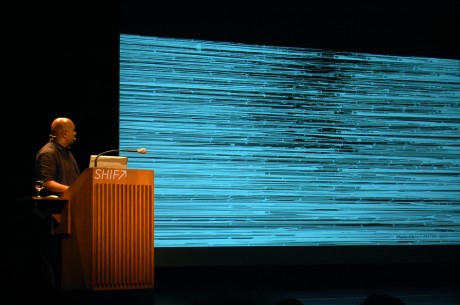
The first problem his team came across a few years ago when integrating text into programming was that the letters were integrated as objects and the resulting language didn’t come out. Jason began by presenting three projects he has been working on the past years with students and colleagues to overcome this textual object problem.
• Next Text Program. An interactive system where text responds to human movements. So in order to read without getting tired you have to behave, stand still and the text wraps the shape of your body on the screen you are facing. This idea was thought out after observing interactive events where people tend to move alot. A sound version was also developed in which the text reacts to the speed and tone of your voice.
• City Speak. A series of screens of different sizes installed indoors and outdoors to which people could send sms’s, they would then be arranged in lines and columns to fill up the page in different colors.
• Poem. A tactile way of interacting by touching or swiping the screen. On one version you could drag your finger around the screen and the text would appear following your path. On another version simply touching a letter was enough to reveal the group of words that you could then drag and rearrange on the screen. The third version had organic shaped groups of letters swimming across the screen, you could catch one and fiddle around with it to discover the content of the text. Poem has since been introduced to the I-Pad, the app is available here : www.poemm.net/
All three projects can be seen at www.obxlabs.net/
Jason finished by presenting us an experimental typographic text editor, Mr.Softie, the latest version just came out today. This application focuses on text as a visual ingredient, the aim of the app is to produce high resolution images but also animations using vectors to reach any scale. You can learn more about the app and download it for free here : www.mrsoftie.net/




















